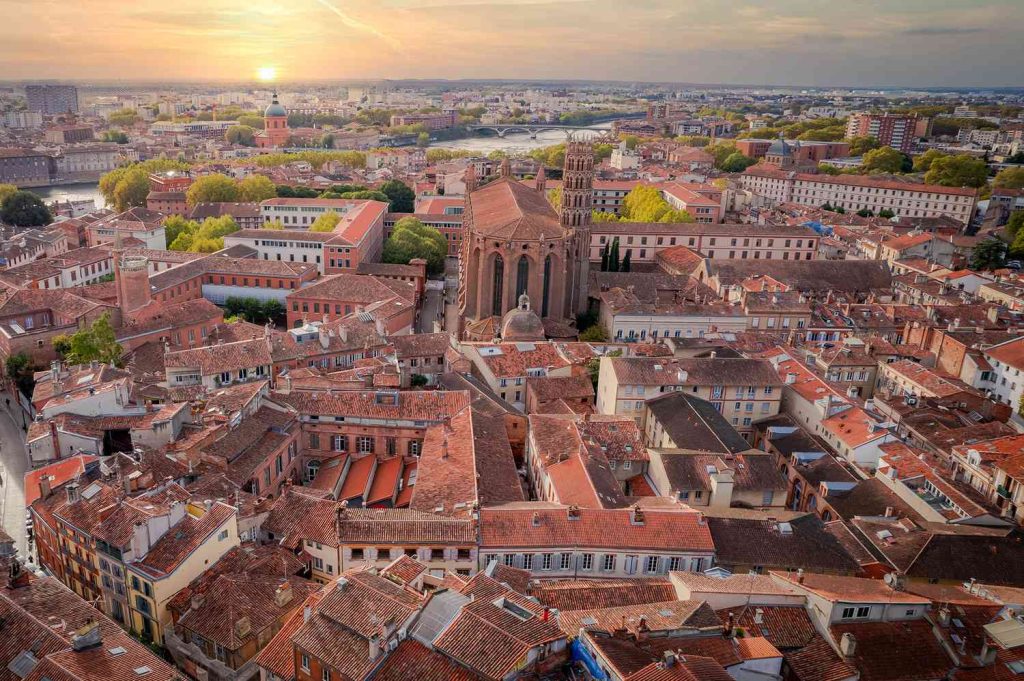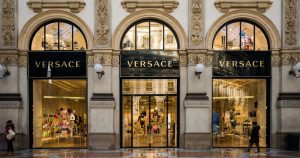:max_bytes(150000):strip_icc():format(jpeg)/TAL-header-city-center-toulouse-france-PINKFRENCHCITY0125-fea902015fa645d4b563a073ee43ce1c.jpg)
As I walked along the riverfront walkway from Pont Neuf at sunset, I basked in the delight of another successful French getaway. During my five-night trip, I had ticked off all the checkboxes of a well-spent French vacation. I found a favorite bakery, made (numerous) trips to Monoprix, visited airy cathedrals with sunshine-illuminated stained glass windows, sampled produce and cheese at a local market, and embarked on multiple museum outings to view works produced by master artists like Claude Monet and Auguste Rodin.
But there’s a catch: I wasn’t in Paris.
Instead, I visited the country’s fourth largest city, set in the southeastern province of Occitanie: Toulouse, France.
Much like Paris, the city is situated on a river, the Garonne, which is (in my opinion) just as romantic as the Seine. It even has a waterfront pathway as well as a series of bridges, including its own Pont Neuf. And while the capital has Canal Saint-Martin, Toulouse has Canal du Midi — while the former is just shy of three miles in length, the latter is part of a nearly 223-mile waterway linking the Atlantic Ocean to the Mediterranean. It’s so impressive that it was inscribed as a UNESCO World Heritage Site in 1996.
Rémi Deligeon/Courtesy of Agence d’Attractivité Toulouse
Toulouse is much less touristed than the City of Light, but it’s certainly not short on notable attractions. Parts of the famed pilgrimage route, the Camino de Santiago, run through the city, and you can find several points of cultural significance along its path including Basilique Saint-Sernin and the Hôtel-Dieu Saint-Jacques, a hospital founded in the 12th century that catered to sick pilgrims.
There are plenty of other historic marvels to see, such as the gothic medieval architectural wonder, the Jacobins Convent (don’t skip out on a stroll through the cloistered garden), as well as the Fondation Bemberg Museum. The museum just reopened last year after three years of intense renovations, and its vast collection of artwork — including 1,400 pieces of paintings, sculptures, furniture, and more — is available to the public once again.
When it comes to shopping, Paris’ most famous department store Galeries Lafayette has a hearty outpost here, as do French brands Comptoir des Cotonniers and The Kooples. But, if you’re seeking something more local, head to AHPY for clothes that have been dyed a pastel, moody blue with isatis tinctoria flowers (also known as dyer’s woad), and to La Maison de la Violette for artisanal creations, which run the gamut from soaps to candies, crafted with sweet violet blossoms.
Toulouse is known for several things. It has a reputation as a college town and is home to Université Toulouse, the second oldest university in the nation, dating back to 1229. It is also widely recognized as one of Europe’s leading aerospace hubs. (In 1890, local engineer Clément Ader flew a bat-like aircraft 164 feet into the air — a flight that predates the Wright brothers’ 1903 aviation feat. Airbus is based in Toulouse, as well as 500 other aerospace manufacturing and engineering companies, which has earned it the title of “Aerospace Valley.”)
That said, Toulouse is perhaps simply best known as La Ville Rose — the Pink City.
Rémi Deligeon/Courtesy of Agence d’Attractivité Toulouse
Unlike Paris, with its mishmash of eclectic architectural styles, Toulouse has a much more unified look, and it’s characterized by its eye-catching, terra-cotta brick buildings. The Toulousean tradition of brick construction dates back to the 12th century and began with centrally-located structures, such as the Basilica of Saint-Sernin and Le Capitole, and radiated outward to the rest of the city.
The bricks in Toulouse have a unique, soft-reddish hue that casts a terra-cotta glow on everything around them. To complement the rosy color, many businesses in the historic part of Toulouse are required to use brass signage. (Yes, that means the McDonald’s golden arches actually look gold here!)
But Toulouse’s distinct fascination with the intersection of art and technology is perhaps best experienced with a visit to La Halle de la Machine, an interactive museum sited on a decommissioned runway. The runway is now populated by enormous, elaborate animatronics — some, such as the 47-ton, 46-foot-tall Minotaur and Ariadne, the Spider — can even take you for rides on their backs.
During the October weekend I visited, the Minotaur and Ariadne turned the city streets into a stage for the urban opera, Le Gardien du Temple, and drew a crowd of 1.2 million people. The performance felt like a real-life science fiction movie, with flames, smoke, and live music, adding to the thrills.
Arnaud Späni/OT de Toulouse/courtesy of CRTL Occitanie
All that sightseeing is sure to make you hungry, and there is no shortage of places to eat in Toulouse. Occitanie is one of France’s major agricultural regions and you can’t visit without taking a trip to one of the city’s trio of covered markets, especially Marché Victor Hugo.
Overwhelmed with the delightfully dizzying array of stands, I hopped on a Taste of Toulouse’s small-group tour led by Michigan native, Jessica Hammer, a French Wine Scholar, and former cheesemonger. As we shopped, snacked, and sipped our way through the aisles, Hammer shared her love of the French city she’s called home for seven years.
“Like Paris, Toulouse has a very vibrant food and drink scene with chef-driven restaurants featuring locally sourced products, covered markets, amazing wine bars, craft cocktails, world-class chocolatiers, and more — but it’s so much less expensive than Paris,” she told Travel + Leisure. “People here love good food and drink . . . the emphasis is on the ingredients.”
During our market visit, she got me so hooked on boulangerie Maison Beauhaire (headed by baker Jean-Luc Beauhaire, who has earned the coveted title of Meilleur Ouvrier de France) that I went back every morning for a chocolate croissant. Take note: Toulousians have a regional name for pain au chocolate — chocolatine. It’s exactly the same pastry, but those who use the “wrong” name will be corrected. (Or, as the joke goes, charged more!)
G. DESCHAMPS/Courtesy of CRTL Occitanie
My wildest French cheese dreams came true when Hammer took us across the street to Xavier Fromagerie, whose head fromager, Xavier Thuret, also has a Meilleur Ouvrier. My love for stinky cheese was satisfied with the bleu d’hougarou, a raw sheep milk blue cheese that originates from the Hautes Pyrénées, a region just southwest of the city. Other impressive culinary stops included the charcuterie Maison Garcia — don’t skip the saucisson from Spanish producer Juan Pedro Domeq, which is requested by royalty and celebrities alike — and Chai Vincent with its wide range of local wines.
In the evenings, I indulged in French gastronomy at local spots like La Gourmandine and Emile, enjoying dinners paired with fine wine and even finer conversations. (Fun fact: long, leisurely dinners are such an integral part of the French cultural experience that the tradition earned a spot on UNESCO’s Representative List of the Intangible Cultural Heritage of Humanity.) Most restaurants in Toulouse have cassoulet on the menu, a famous regional stew typically consisting of white beans, pork, and duck.
Dominique VIET/Courtesy of CRTL Occitani
Another one of Toulouse’s major appeals is its location, as it’s about halfway between the Atlantic and the Mediterranean and offers easy access to the Pyrenees mountains as well as Bordeaux’s famed vineyards. With Toulouse as a home base, the entire region of Occitanie turns into a playground.
Plus, it has all the perks of a Parisian getaway, at a fraction of the cost. (For example, the average Toulouse hotel room is around $259 per night, compared to Paris’ average of $538 per night.)
If adventures beyond Toulouse are on your wish list, there’s no shortage of things to do in the area. During my trip, I packed in several local excursions and visited places like Albi and its UNESCO-recognized Old Town, the quiet, charming town of Auch, as well as the dreamy village of Cordes-sur-Ciel, which sits high upon a hill, seemingly above the clouds. On one outing, I even got to play assistant skipper, helping wrangle ropes on a canal boat as we navigated through Canal du Midi’s locks in Castelnaudary.
“Toulouse has many of the same benefits as Paris, but without the FOMO or the rush,” Hammer told T+L. “Part of the charm of the city is just melting into its relaxing embrace. Wander through the streets, enjoy the café terrace culture, and walk along the river or the canal. It’s a city of small delights because you can take the time to slow down and notice things.”
But perhaps the city’s charm is best summarized with its regional take on the phrase “you’re welcome.” Instead of the typical de rien, meaning “it’s nothing,” it’s more common for locals to respond to a thank you avec plaisir, or “with pleasure.”
“That, to me, is Toulouse in a nutshell,” Hammer said.








